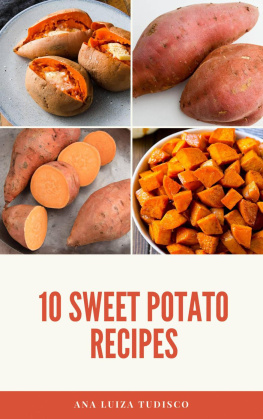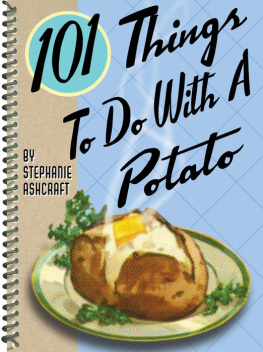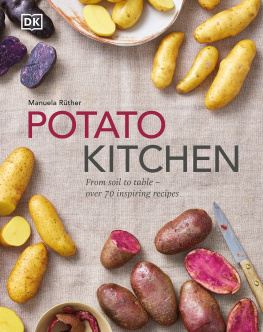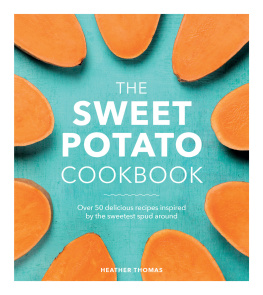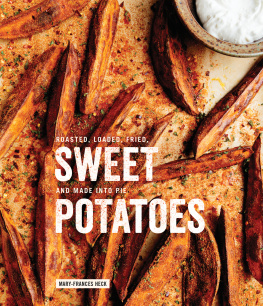a SAVOR THE SOUTHcookbook
Sweet Potatoes
SAVOR THE SOUTHcookbooks
Sweet Potatoes, by April McGreger (2014)
Southern Holidays, by Debbie Moose (2014)
Okra, by Virginia Willis (2014)
Pickles and Preserves, by Andrea Weigl (2014)
Bourbon, by Kathleen Purvis (2013)
Biscuits, by Belinda Ellis (2013)
Tomatoes, by Miriam Rubin (2013)
Peaches, by Kelly Alexander (2013)
Pecans, by Kathleen Purvis (2012)
Buttermilk, by Debbie Moose (2012)
2014 April McGreger
All rights reserved. Manufactured in the United States of America.
SAVOR THE SOUTH is a registered trademark of the
University of North Carolina Press, Inc.
Designed by Kimberly Bryant and set in Miller and
Calluna Sans types by Rebecca Evans.
The paper in this book meets the guidelines for permanence and durability of the Committee on Production Guidelines for Book Longevity of the Council on Library Resources. The University of North Carolina Press has been a member of the Green Press Initiative since 2003.
Jacket illustration courtesy of John Gollop/Getty Images.
Library of Congress Cataloging-in-Publication Data
McGreger, April.
Sweet potatoes / April McGreger.
pages cm. (Savor the South cookbooks)
Includes bibliographical references and index.
ISBN 978-1-4696-1766-4 (cloth : alk. paper)
ISBN 978-1-4696-1767-1 (ebook)
1. Cooking (Sweet potatoes) 2. Cooking, AmericanSouthern style. I. Title.
TX803.S94M39 2014 641.6522dc23 2014009212
18 17 16 15 14 5 4 3 2 1
The Sweet Potato Grits recipe in this book is reprinted with permission from Virginia Willis, Basic to Brilliant, Yall: 150 Refined Southern Recipes and Ways to Dress Them Up for Company (Berkeley: Ten Speed Press, 2011), 2011; for more information, visit www.virginiawillis.com.
To my father, Earl McGreger,
nurturer of field, family, and community
Contents
a SAVOR THE SOUTHcookbook
Sweet Potatoes
Introduction
Sweet potatoes are as rampant as the kudzu vine all over the South.
Betty Fussell, I Hear America Cooking
Certain foods are of such significance to my identity that I am bound and determined to pass on a love for them to my son. He will love field peas; he will love cornbread; he will love okra and chicken and dumplings and boiled peanuts; and he will love sweet potatoes. These foods are not just important to me; they are me. In serving my son these foods, I am passing on a love for them that is greater than a love of the way they taste. In the wise words of New Orleanss passionate cooking teacher and culinary historian Poppy Tooker, we have to eat it to save it. We are not only saving such foods but also passing on our cultural identity to the next generation in the process. And is there any food more central to our southern identity than sweet potatoes?
The sweet potato was of such importance in the pastoral Piney Woods of Mississippi in 1840 that a traveler noted that it was the only crop cultivated in this region of poor white cattle and hog grazers. It was so versatile and dependable that it was the only crop needed. It was reported that the traveler ate sweet potatoes with wild turkeys and various other meats, had a potato pie for dessert and roasted potatoes offered to him as a side dish, drank sweet potato coffee and sweet potato home brew, had his horse fed on sweet potatoes and sweet potato vines, and when he retired he slept on a mattress stuffed with sweet potato vines and dreamed he was a sweet potato someone was digging up.
A life so dependent on one crop may be difficult to fathom, but not much has changed in my hometown of Vardaman, Mississippi, in the nearly 175 years since that time. It is a place where the sweet potato is not just a southern food but the center of a whole network of ties to community, economics, and identity. The annual Sweet Potato Festival, held on the first Saturday in November, culminates a weeklong celebration of the annual harvest with sweet potatocooking contests, tasting booths offering everything from sweet potato sausage balls to sweet potato bonbons, and, in true southern fashion, a Sweet Potato Queen.
As the daughter and sister of sweet potato farmers in the self-proclaimed Sweet Potato Capital of the United States, I consider sweet potatoes a mainstay of my family dinner table. In addition to sustenance, they have provided their share of life lessons. By the time I was a teenager, I had worked at pulling slips, the shoots that densely bedded seed sweet potatoes send up, and had spent a couple of summers riding the setter that plants those sweet potato slips in expansive fields. I learned firsthand how eyes and ears and noses fill with dust from the warm, just-plowed earth and how the modern farmers schedule is set by nature and financial demands, often at odds with each other. By then I knew, too, of the sweet potatos versatility in the kitchen and that, after a few early failures in pursuit of the Little Miss Sweet Potato Queen title , I was more apt to win my sweet potato accolades there than on the pageant stage.
It is a southern tradition to have a story for everything, and the sweet potato delivers a fascinating one. All southernersrich or poor, black or whiteowe no less than their lives to it. During and after the Civil War, sweet potatoes are said to have saved both rich and poor from starvation. Without a doubt, they also provided long-term nutrition to the regions poorest residents, both black and white.
In the story of the sweet potato, we find the themes of loss and redemption that run through much of southern culture. Once such a prominent food in the southern diet, the sweet potato is now eaten by many only on Thanksgiving in the form of sweet potato casserole or sweet potato pie. There was a time in recent history that it would have been embarrassing to admit to enjoying sweet potatoes (and many other lowly foodstuffs such as ramps, grits, collard greens, and chitlins) in educated and middle-class circles. Luckily, times are changing. There is an increasing awareness and valuing of traditional, local foods and a rejection of homogeneity and globalization. A rising tradition of southern chefs starting with the late Edna Lewis and Bill Neal celebrates these seemingly pedestrian southern foods. Food writer John T. Edge sees these themes as part of a larger consciousness of the value of community, which results in knitting back together the tethers of community by way of food.
George Washington Carver said that sweet potatoes were one of the greatest gifts God has ever given us and claimed they had the potential to replenish soils ravaged by King Cotton. Might it finally be time to take heed of this wisdom?
Early History of the Sweet Potato: Origins and Discovery
The sweet potato was grown in the southeastern United States long before the first Europeans arrived. De Soto found sweet potatoes being cultivated by Native Americans in Louisiana and as far north as Georgia in 1540. By 1648, the Virginia colonists were growing them. The Native American provenance of sweet potatoes is reflected in an early recipe resembling sweet potato spoonbread that appears in The Carolina Housewife under its Indian name, Espetanga Corn Bread.
Archaeological evidence suggests that the sweet potato was domesticated in the Americas at least as far back as 2000 B.C. and possibly as early as 8000 B.C. The latter possibility would make sweet potatoes the earliest major crop planted anywhere in the world. The first known European discovery of sweet potatoes was when Columbus found them growing in Haiti in 1492 and transported them back to Spain, thus making them one of the earliest New World foods adopted in Europe. They were called by their Arawak name




